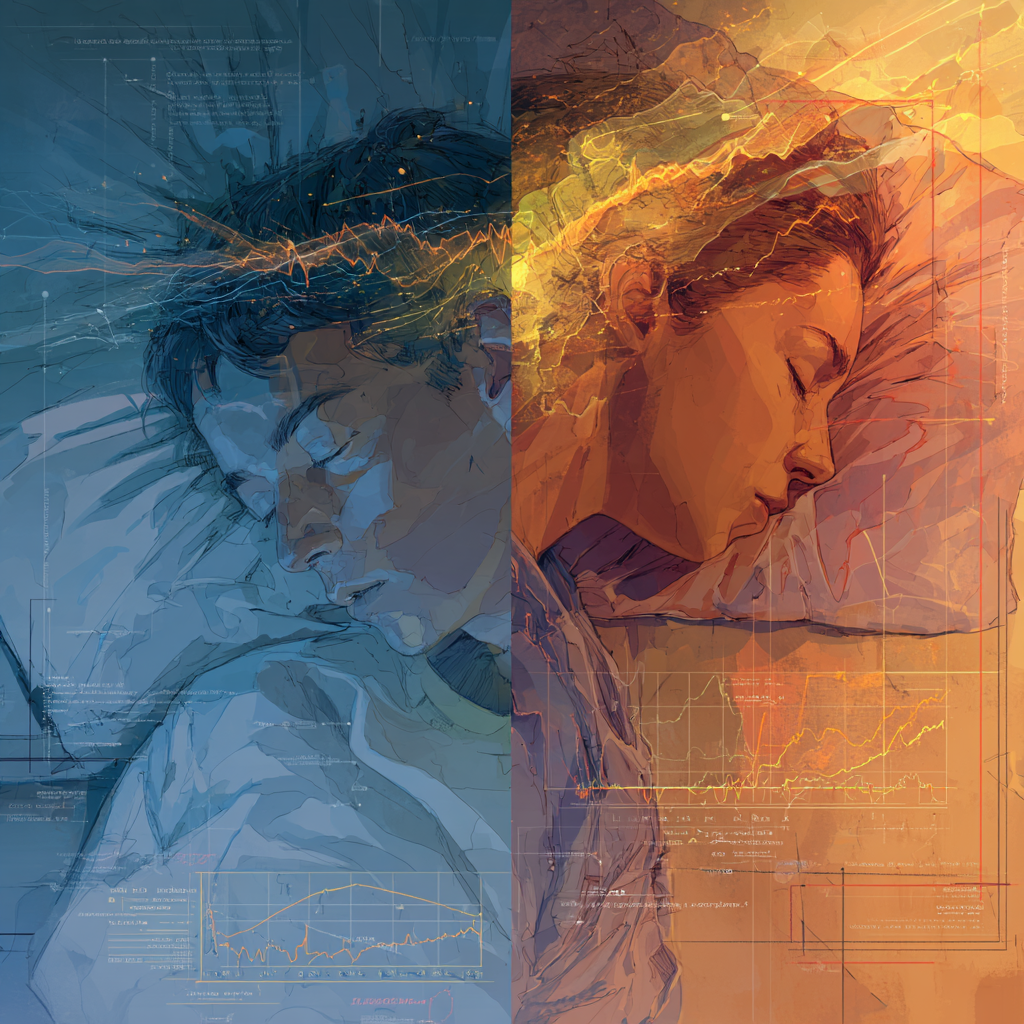Treating Fatigue Associated with Nocturnal Sleepwalking: Beyond the Symptom to Sleep Architecture Solutions

Story-at-a-Glance
• Fatigue from sleepwalking is often the visible tip of a deeper sleep architecture problem – addressing it requires understanding how parasomnias disrupt the natural progression through sleep stages
• Recent research reveals sleepwalkers experience significantly higher rates of daytime sleepiness, fatigue, and reduced quality of life compared to healthy controls, based on comprehensive studies from 2013 showing this represents a serious medical concern rather than just a nighttime curiosity
• Sleep deprivation acts as both a trigger and consequence of sleepwalking episodes, creating a vicious cycle that compounds fatigue and requires targeted intervention strategies
• Effective treatment involves optimizing overall sleep hygiene, managing underlying sleep disorders, and sometimes medication – but the approach must be individualized based on the specific factors driving each person’s episodes
• The connection between sleepwalking and mental health conditions like anxiety and depression means comprehensive treatment often requires addressing both the parasomnia and associated psychological factors
The Hidden Epidemic of Sleepwalking Fatigue
Recently, researchers at the University of Montpellier published findings that should concern anyone who’s ever dismissed sleepwalking as merely “quirky” nighttime behavior.
Dr. Yves Dauvilliers and his team discovered in their comprehensive case-control study that adult sleepwalkers showed significantly higher rates of daytime sleepiness, fatigue, insomnia, depressive and anxiety symptoms, and reduced quality of life compared to people without the condition. This wasn’t a small study of a few dozen participants – it represented a comprehensive look at how parasomnias fundamentally alter the quality of our waking hours.
The implications are staggering. What many people experience as occasional nighttime wandering is actually a complex neurological event that fragments sleep architecture, disrupts restorative processes, and leaves people feeling chronically exhausted during the day. Yet most sufferers – and even some healthcare providers – focus primarily on the dramatic nighttime episodes while overlooking the debilitating daytime consequences.
This represents a fundamental misunderstanding of how sleep disorders work. Treating fatigue associated with nocturnal sleepwalking isn’t just about managing tiredness; it’s about addressing a cascade of neurological and physiological disruptions that begin deep within our sleep cycles.
Why Traditional Approaches Fall Short
Something troubling emerges when we examine how we typically approach sleep-related fatigue: we treat symptoms rather than systems.
Most people experiencing sleepwalking-related exhaustion try the obvious solutions first – more caffeine, earlier bedtimes, weekend “catch-up” sleep. But these approaches often backfire. Why? Because sleepwalking fundamentally alters the architecture of sleep itself, making it less restorative even when you’re getting adequate hours. Dr. Yves Dauvilliers, Professor of Neurology at the University of Montpellier and specialist in sleep disorders, has spent decades studying how parasomnias disrupt normal sleep processes. His research reveals that sleepwalking episodes typically emerge from slow-wave sleep – precisely the stage most critical for physical restoration and memory consolidation.
Think about what this means: every sleepwalking episode represents not just a disruption to that night’s rest, but a fundamental interference with your brain’s ability to repair and recharge itself. The fatigue you feel isn’t just from “losing sleep” – it’s from having your sleep quality compromised at the neurological level.
The Sleep Deprivation Paradox
Here’s where things get particularly complex, and where many treatment approaches go wrong.
Research shows that “sleep deprivation increases sleepwalking episodes in the sleep laboratory,” creating what sleep specialists call a “vicious cycle.” You’re tired because you sleepwalk, but being tired makes you more likely to sleepwalk. It’s a neurological catch-22 that requires sophisticated intervention.
A case study perfectly illustrates this paradox: a 34-year-old software engineer who started experiencing sleepwalking episodes during a particularly stressful project deadline. The initial episodes were minor – walking to the kitchen, opening cabinets, returning to bed. But as the stress continued and his sleep became more fragmented, the episodes became more frequent and complex.
The fascinating part? Even after the work stress resolved, the sleepwalking continued. His sleep debt had created a neurological pattern that persisted independent of the original trigger. This highlights why treating sleepwalking-related fatigue requires more than just addressing obvious stressors.
What’s the solution? We need to break the cycle strategically. This often means temporarily prioritizing sleep quantity and quality over other factors, using targeted interventions to restore normal sleep architecture, and then maintaining those gains through sustainable long-term practices.
The Neurological Reality of Parasomnia Fatigue
Let me share something that changed how I understand sleep disorders: parasomnias aren’t just behavioral quirks – they’re windows into disrupted brain states.
During normal sleep, your brain cycles through distinct stages, each serving specific restorative functions. Deep sleep (stages 3 and 4) is when your body releases growth hormone, consolidates memories, and performs cellular repair. REM sleep handles emotional processing and cognitive maintenance.
Sleepwalking typically occurs during the transition out of deep sleep. This means that not only are you losing the restorative benefits of that sleep stage, but your brain is essentially “stuck” between sleep and wake states – not fully benefiting from either.
The research on this is compelling. Studies show that 24-38 hours of sleep deprivation can trigger confusional arousals and sleepwalking in 90% of clinically diagnosed sleepwalkers in laboratory settings. This suggests that sleepwalking represents a fundamental vulnerability in how certain people’s brains manage sleep-wake transitions.
But here’s what gives me hope: understanding this mechanism also points toward effective interventions. If sleepwalking emerges from disrupted sleep architecture, then optimizing that architecture becomes our primary therapeutic target.
Real-World Treatment Strategies That Work
After years of research and observation, I’ve identified several approaches that consistently help people reduce both sleepwalking episodes and associated fatigue. The key is addressing the underlying sleep system, not just the symptoms.
1. Sleep Hygiene with Parasomnia-Specific Modifications
Standard sleep hygiene advice often needs modification for sleepwalkers. Simply “going to bed earlier” isn’t enough – you need to optimize the conditions that promote stable sleep architecture.
Essential modifications include:
- Temperature regulation: Keep your bedroom cooler than typical recommendations (65-67°F). Sleepwalkers often have altered temperature regulation during sleep transitions.
- Consistent sleep debt management: Avoid the weekend “catch-up sleep” trap that can destabilize your circadian rhythm.
- Strategic napping: If you must nap, limit it to 20 minutes and avoid napping after 3 PM, as longer naps can increase deep sleep pressure and potentially trigger episodes.
2. Stress and Anxiety Management
Research consistently links anxiety, stress, childhood trauma, and PTSD to increased sleepwalking risk. This isn’t coincidental – these conditions all affect the same neurological pathways involved in sleep-wake transitions.
One approach I’ve seen work particularly well involves targeted relaxation techniques practiced specifically during the pre-sleep period. This might include progressive muscle relaxation, breathing exercises, or mindfulness practices – but the key is consistency and timing.
3. Medical Evaluation for Underlying Conditions
Thyroid conditions, particularly hyperthyroidism, can trigger sleepwalking episodes. This is why comprehensive medical evaluation is crucial for anyone experiencing frequent episodes with associated fatigue.
Don’t overlook the possibility of other sleep disorders occurring simultaneously. Sleep apnea, restless leg syndrome, and periodic limb movement disorder can all coexist with sleepwalking and compound fatigue issues.
When Professional Help Becomes Necessary
A common misconception exists that sleepwalking is always benign and self-resolving.
The reality is more nuanced. As Dr. Dauvilliers notes, “Sleepwalking is an underdiagnosed condition that may be clearly associated with daytime consequences and mood disturbances leading to a major impact on quality of life.” Sleep specialists have tools that go far beyond what you can achieve through self-management.
Consider professional evaluation if you experience:
- Sleepwalking episodes more than twice per month
- Episodes involving complex behaviors or potential danger
- Persistent daytime fatigue despite adequate sleep hours
- Associated mood changes, anxiety, or depression
- Episodes that began or worsened in adulthood
Sleep specialists have tools that go far beyond what you can achieve through self-management. These include sleep studies that can identify concurrent disorders, specialized medications when appropriate, and cognitive-behavioral therapy techniques specifically designed for parasomnias.
The Medication Question: When and Why
Questions about medication for sleepwalking and associated fatigue arise frequently.
The answer isn’t straightforward – it depends entirely on individual circumstances and underlying causes. Some medications can be helpful: Clonazepam is sometimes prescribed for frequent, disruptive episodes, antidepressants may help when anxiety or depression are contributing factors, and melatonin can sometimes help stabilize sleep architecture, though timing and dosage are critical.
However, medication should never be the first or only intervention. The goal is always to optimize natural sleep processes whenever possible, using medications as temporary support while addressing underlying issues.
The Long-Term Perspective: Building Sustainable Sleep Health
Here’s something I’ve learned from years of studying sleep disorders: sustainable improvement requires thinking systemically rather than symptomatically.
Treating fatigue associated with nocturnal sleepwalking isn’t just about feeling less tired tomorrow – it’s about creating conditions that support optimal sleep architecture for years to come. This means developing habits and environmental conditions that naturally promote stable sleep-wake transitions.
The most successful approaches I’ve observed share common characteristics:
- They address multiple factors simultaneously (sleep hygiene, stress management, underlying health conditions)
- They’re sustainable long-term rather than requiring heroic daily effort
- They’re individualized based on specific triggers and patterns
- They include monitoring and adjustment over time
A Personal Reflection on Sleep and Modern Life
Sometimes questions arise about whether we’ve lost touch with sleep as a natural, essential biological process rather than just “downtime” between productive activities.
Our modern lifestyle creates perfect conditions for parasomnia development: irregular schedules, chronic stress, excessive screen time, and cultural pressure to “optimize” everything, including sleep. Perhaps the rise in adult sleepwalking and associated fatigue reflects our disconnect from natural circadian rhythms. This doesn’t mean we need to return to pre-industrial sleep patterns, but it does suggest that sustainable solutions require working with our biology rather than against it.
The most effective treatments honor the complexity of sleep as an active, restorative process rather than treating it as a simple on/off switch.
Looking Forward: Emerging Research and Hope
The field of parasomnia research is evolving rapidly, and there’s reason for optimism.
Emerging areas of investigation include: genetic factors that might predict sleepwalking susceptibility, advanced neuroimaging techniques that reveal brain activity during episodes, personalized treatment approaches based on individual sleep architecture patterns, and technology-assisted monitoring and intervention strategies. What excites researchers most about current studies is the focus on understanding individual variation.
Not all sleepwalkers are the same, and not all will respond to identical treatments. The future of parasomnia management lies in precision approaches that account for each person’s unique neurological, psychological, and lifestyle factors.
FAQ
Q: How common is fatigue among adult sleepwalkers?
A: Recent research by Dr. Yves Dauvilliers found significantly higher rates of daytime sleepiness and fatigue in adult sleepwalkers compared to control groups, along with associated mood disturbances and reduced quality of life. This makes fatigue one of the most consistent daytime consequences of nocturnal sleepwalking episodes.
Q: Can treating fatigue reduce sleepwalking episodes?
A: Since sleep deprivation increases sleepwalking episodes, addressing fatigue and optimizing overall sleep quality can indeed reduce episode frequency. However, it’s important to address fatigue through sleep architecture improvements rather than just increasing sleep duration, as the quality of sleep matters more than quantity for sleepwalkers.
Q: What’s the difference between normal tiredness and sleepwalking-related fatigue?
A: Sleepwalking-related fatigue typically feels more persistent and doesn’t improve significantly with extra sleep. This occurs because sleepwalking episodes disrupt the deep sleep stages most critical for restoration, so even adequate sleep hours may not provide adequate recovery. People often describe feeling “unrefreshed” upon waking despite sleeping 7-8 hours.
Q: Is it safe to wake someone who is sleepwalking?
A: While it won’t cause harm, waking a sleepwalker can be disorienting and potentially startling for them. It’s generally better to gently guide them back to bed. However, if they’re in immediate danger, waking them may be necessary for safety.
Q: What underlying conditions should be ruled out for adult-onset sleepwalking?
A: Key conditions include thyroid disorders (particularly hyperthyroidism), anxiety disorders, PTSD, and brain-related diseases. Additionally, other sleep disorders like sleep apnea or restless leg syndrome can coexist with sleepwalking and compound fatigue issues.
Q: What does “sleep architecture” mean?
A: Sleep architecture refers to the natural pattern and structure of sleep, including the progression through different sleep stages (light sleep, deep sleep, and REM sleep) throughout the night. Healthy sleep architecture involves cycling through these stages in a predictable pattern that allows for proper restoration and recovery.
Q: What are parasomnias?
A: Parasomnias are abnormal behaviors, movements, emotions, perceptions, or dreams that occur during sleep transitions or within specific sleep stages. Sleepwalking is one type of parasomnia, along with night terrors, sleep talking, and REM sleep behavior disorder.
Q: What does REM sleep do?
A: REM (Rapid Eye Movement) sleep is the stage when most vivid dreaming occurs. During REM sleep, the brain processes emotions, consolidates memories (especially procedural and emotional memories), and performs important cognitive maintenance functions.
Q: What is slow-wave sleep?
A: Slow-wave sleep, also called deep sleep or stages 3 and 4 of non-REM sleep, is the most restorative sleep stage. This is when the body releases growth hormone, consolidates declarative memories, and performs cellular repair. Sleepwalking typically occurs during transitions out of this stage.
Q: What does PTSD stand for and how does it relate to sleepwalking?
A: PTSD stands for Post-Traumatic Stress Disorder, a mental health condition that can develop after experiencing or witnessing traumatic events. PTSD can disrupt normal sleep patterns and increase the likelihood of parasomnias like sleepwalking by affecting the same neurological pathways involved in sleep-wake transitions.
Q: How long does it typically take to see improvement in sleepwalking-related fatigue?
A: Improvement timelines vary significantly based on underlying causes and treatment approaches. Sleep hygiene modifications may show benefits within 2-4 weeks, while addressing underlying medical or psychological conditions may take several months. The key is consistency and addressing multiple factors simultaneously rather than expecting quick fixes.
Q: Can sleepwalking be completely cured?
A: While there’s no universal “cure” for sleepwalking, most people can significantly reduce episode frequency and associated fatigue through comprehensive management approaches. The goal is typically management and optimization rather than complete elimination, as some genetic predisposition may always remain.
Q: Are there specific sleep positions or arrangements that help prevent episodes?
A: While sleep position doesn’t directly prevent sleepwalking, environmental safety modifications are crucial. This includes removing obstacles, securing windows and doors, and ensuring clear pathways. Some people find that sleeping on the ground floor reduces safety risks associated with episodes.
Q: What role does diet play in sleepwalking and associated fatigue?
A: While diet isn’t a primary trigger for most people, large meals close to bedtime, excessive caffeine, and alcohol can all disrupt sleep architecture and potentially increase episode likelihood. Focus on stable blood sugar levels and avoiding substances that interfere with deep sleep stages.
Q: Should family members intervene during sleepwalking episodes?
A: Family members should prioritize safety while minimizing disruption. This means gently guiding the person back to bed if possible, ensuring they don’t encounter hazards, and avoiding loud noises or sudden movements that might cause confusion or distress. The goal is protection without causing additional sleep disruption.

